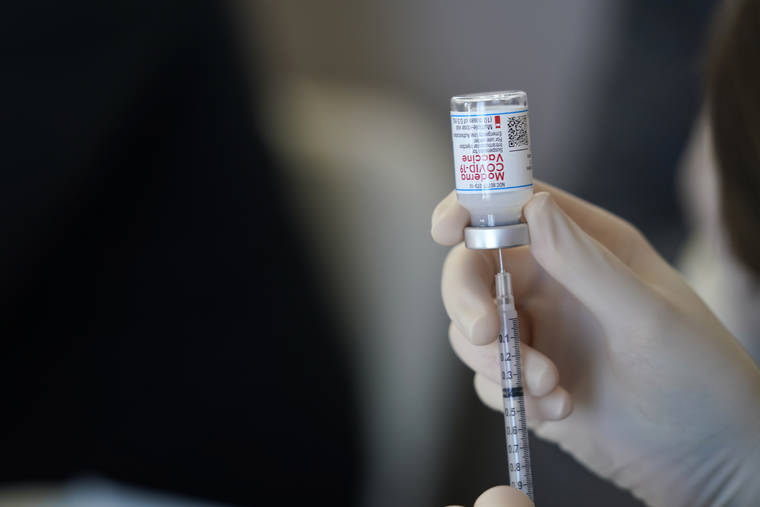
Monique Chyba, a mathematics professor generating regular forecast models of COVID-19 cases in Hawaii, could very well say, “I told you so.”
But Chyba, a University of Hawaii professor working with the Hawaii Pandemic Applied Modeling Work Group, a voluntary partnership of Hawaii-based epidemiologists, scientists and health professionals, says she would take no pleasure in saying so because the state is now in “a crisis mode.”
Her Aug. 5 model, in which she projected an average of about 400 cases a day for Honolulu growing to beyond 600, with continued increases to a peak of about 1,200 in October, was pretty much on track.
On Aug. 5, Hawaii’s single- day number of new coronavirus cases spiked to 655, which at that time was a record high.
But then Honolulu’s surge swelled with a high of 845 daily new cases Aug. 15.
Based on the higher numbers, Chyba generated another forecast Aug. 15 that shows daily coronavirus cases in Honolulu continuing to grow past 1,000 in September and peaking to about 3,700 cases Oct. 8 if the state remains on course with its current level of mitigations and vaccination rates.
That’s three times higher than her projection from Aug. 5.
“Mathematics do not lie,” she said. “I would have loved the predictions to go wrong, but while mathematical modeling cannot account for people’s behavior, it interprets the data and it keeps telling us what’s there.”
On Sunday the state reported a new record high of 893 infections statewide. Honolulu’s seven-day average of new cases was at 451, with a positivity rate of 9.4%.
Another forecast model for active hospitalizations on Honolulu shows a curve rising beyond 500 in September, surpassing 1,000 in October and peaking at about 2,290 in late October.
What would be ideal, she said, is to “smoosh” that peak down significantly, and flatten the curve over a longer period of time. This would translate into more manageable numbers for hospitals to deal with.
“We are swimming in the delta variant,” she said. “That is what’s driving this. Right now it’s completely overwhelming us.”
And it gets worse. Chyba said the daily reported cases are only “the tip of the iceberg.”
Her team generated a model estimating the number of active cases among asymptomatic individuals, which often go undetected. If those cases are accounted for, it would bring the total number of cases on Aug. 15 to 16,500.
Her model estimated that 66% of those who are undetected, or “silent carriers,” are fully vaccinated and, therefore, mostly asymptomatic.
Data for the number of asymptomatic individuals with COVID-19 is unavailable, according to Chyba, and would be available only if the entire population of Hawaii was tested daily, which is not possible. But mathematical models can show the invisible, she said, assuming the known numbers are only the tip of the iceberg.
The forecasts will fluctuate depending on other factors, she said, adding that “you cannot speculate on people’s behavior or on vaccinations.”
Whether people will change their behavior, mask up and refrain from gathering could make an impact but remains unpredictable and is not factored into the model, she said.
Chyba said her original forecasts from late July, which had numbers peaking in the high 100s, were adjusted to much higher numbers because she had expected more of Hawaii residents to be vaccinated by now.
If Hawaii reaches higher vaccination rates, the model would change.
“What people need to understand is a small increase in vaccination, even 4% or 5%, has a huge impact on this model,” she said.
HiPAM Chairwoman Victoria Fan said in an email that mask use remains an important tool in controlling COVID-19.
Fan said Hawaii needs to increase mask use — maintaining masks indoors and increasing masks outdoors — to slow the spread of the coronavirus and curtail hospitalizations. Increasing mask use in the state to 80% could cut new infections by half, she said.
“Masks are a lifesaving defense against the surge in cases, alongside vaccinations and isolation and quarantine,” said Fan. “Every protective step matters and should not be underestimated. Hawaii needs your help to control the surge; we cannot do it without you.”
"peak" - Google News
August 23, 2021 at 05:09PM
https://ift.tt/383EfZt
Hawaii’s daily COVID cases are forecast to peak at 3,700 in October - Honolulu Star-Advertiser
"peak" - Google News
https://ift.tt/2KZvTqs
https://ift.tt/2Ywz40B
Bagikan Berita Ini
















0 Response to "Hawaii’s daily COVID cases are forecast to peak at 3,700 in October - Honolulu Star-Advertiser"
Post a Comment